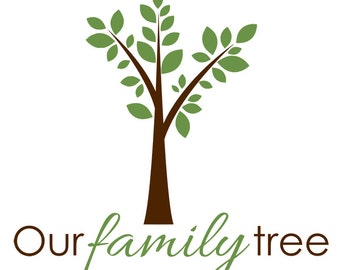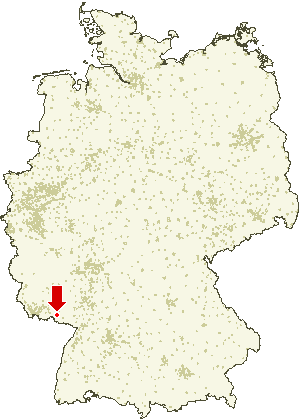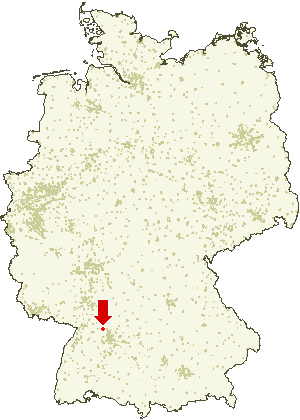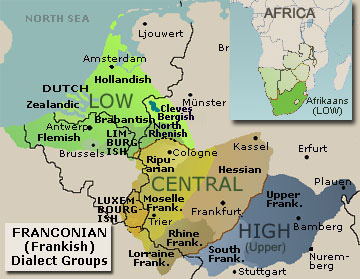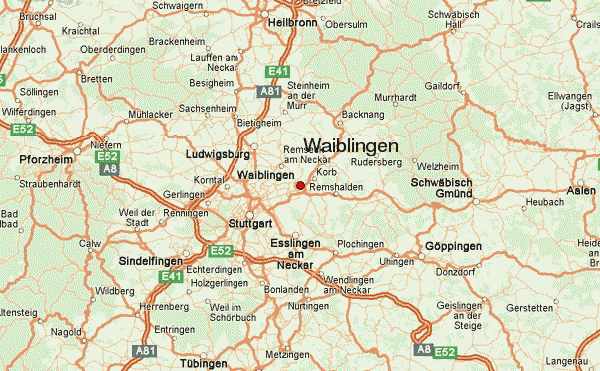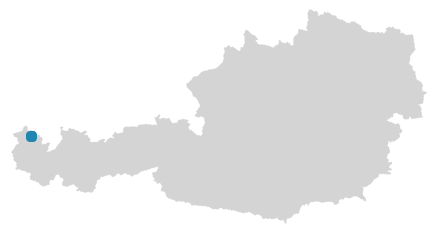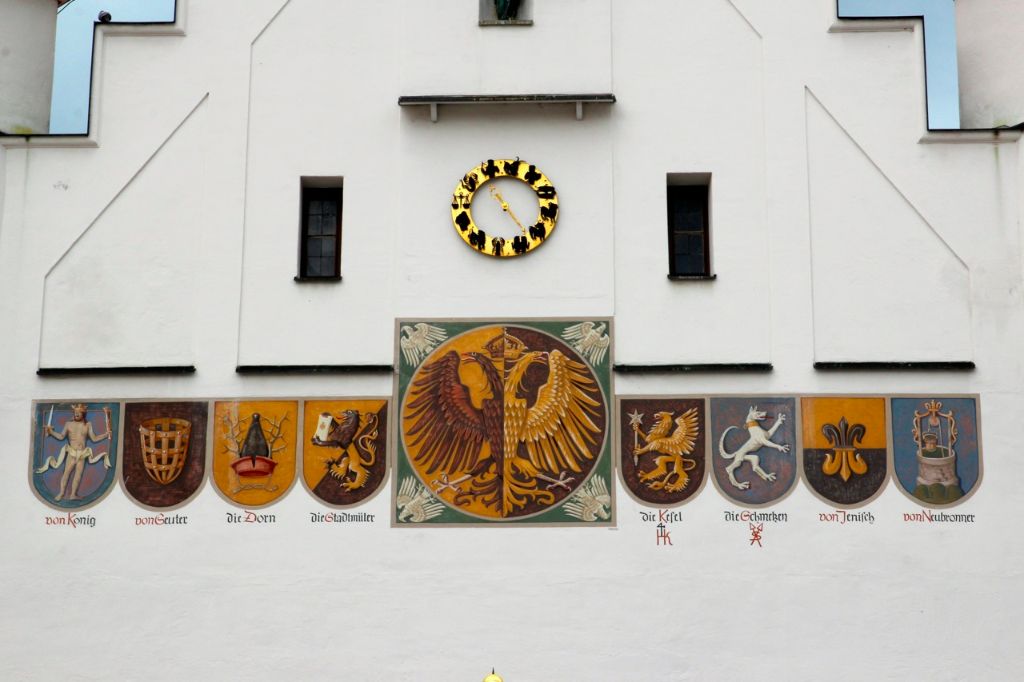Discussing the difference between schOchenmaiers and schAchenmayrs with Janet Schochenmaier from Canada, I have been motivated to do a sort of new research on the last ones. And I was surprised to find out that there is much more information on them than I previously thought.
Let me explain step by step what I came to.
On Google Books, Janet stumbled upon some Gothic quotations from which we might conclude that any Leonhard Freidrich SchAchenmayr had been mayor in Kempten. It's South-West Bavaria, Allgäu area. But, in my post on "knitted Schachenmayrs" (
http://schochenmaiers.blogspot.de/2014/06/on-knitted-schoachenmaiers.html), I presented to your attention a Leonhard SchAchenmayr who had founded a yarn spinning company under his name in Salach. It's about 130 km (80 mi). I asked myself the question if he was the same Leonhard.
I started digging up and several hours after that I found a first link between Kempten and Salach:
So, this Leonhard had been born on 15th December 1791 in Kempten, but he started his "woolen business" in 80 miles in Salach after he married a Marie Catherine Friederike Kolb, daughter of a well-known Bavarian merchant Johann Gottfried Kolb on the 1st March 1824. I am still not sure that that Leonhard was mayor in Kempten from 1824 to 1830 because if he was mayor in Kempten how he could be married in Salach and at the same time be a companion of Mr. Kolb in Salach. But maybe the mayor was his father? As you can see, parents of Leonhard were Leonhard Schachenmayr as well and Sabine Wagenseil.
Reading on the history of Leonhard Schachenmayr and his firm "Schachenmayr and Cie", I found out that his ancestors had been papermakers from Kempten. Then I kept digging down and suddenly I found a pdf file where you can read in German the history of SchAchenmayErs. It's pretty interesting, I will translate it for into English plus I will add pictures willing to illustrate their history.
The pdf file is based on the publication: Wolfgang Petz,
Die Familie Schachenmayer in Kempten und Isny vom ausgehenden Mittelalter bis zur Mitte des 19. Jahrhunderts (Schachenmayer Family in Kempten and Isny from the Late Middle Age up to the middle of the 19th century), Typoskript Kempten 2003.
Let's go!
It's titled as:
Social rise, on the example of the Schachenmayers.
The social rise possibilities can be shown through the history of paper craftsmen from the Early Modern period exemplified by the Sch
achenmay
er family. It probably traces back to the field name of Sch
achen in Langenegg:
Langenegg is a municipality in the district of Bregenz in the Austrian state of Vorarlberg.
It's only 55 km (35 miles) up to Kempten:
Some pictures for your imagination:


It had been under the parish Martinzell earlier. It's already in Germany:


The very first mention is to be found in
1506 when a prince-abbot
... title for a cleric who is a Prince of the Church (like a Prince-Bishop), in the sense of an ex officio temporal lord of a feudal entity, notably a State of the Holy Roman Empire...
reduced the cost of
laudenium (
Latin word meaning the payment for the transfer of land that had to be paid by vassals upon entering into an inheritance) for a leasehold manor or land property in E
schach (Parish of Buchenberg) of the widow of hunter Michel Sch
Achenmayer.
Eschach is in Buchenberg today. But where is it?
It's in 12 km (7 mi) from Kempten and 46 km (28 mi) from Langenegg.
Some pictures of Eschach:


One line of the Schachenmayers, which branched off, is then to be met in the area called
Einöde Feigen (Feigen wasteland) by
Elmatried (Parish St. Lorenz). It's near Kempten now:

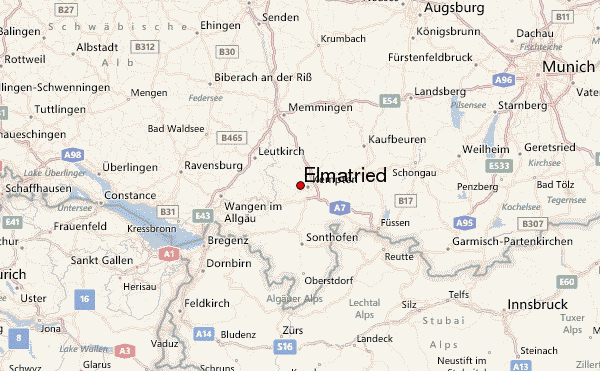
where a
Hans Schachenmayer in
1531/2 paid fees for his leasehold possession. Around
1556 he was already dead, but his taxes had been abated and weren't given over to his children, as it was being used to do at that time, due to their poverty.
Wolfgang Petz suggests that from that impoverished branch of Schachenmayers descends the future family of famous paper-makers.
The uncertain financial situation of leasehold tenure will be drawn through the family history between the 15th and 16th centuries. Unlike the owners of hereditary fief they had no material basis that would have provided them protection for emergencies, as for instance in the case of loss of the breadwinner. The forced mobility led the Schachenmayer in the city. In
1575, the earliest mention of family members in the Council minutes of the imperial town of Kempten confirms that Hans Schachenmayer, his wife Sara Leutz and two children bought the rights of town citizenship. Hans Schachenmayer, as can be inferred from the record, was at that time not in the city itself, but in Rottach (Parish of St. Lorenz) which represtented a scattered settlement outside the urban district on the lower reaches of the river with the same name.

In the civil recording book his profession is mentioned like that:
ain Pappeyrer.
Below some pictures how this job looked like:
Here is the example of the first paper making industry in 1502 from Mühlhausen (Alsace):
Very likely he worked on one of the mills in
Kottern, where he was testified later.

His wife Sara Leutz was Moritz Staiger's granddaughter, daughter of the paper-maker Hans Leutz from Durach, who in his turn had purchased the Civil Rights of the imperial town in 1563. The affinity with the paper industry can be also shown by the fact that one of the two bailsmen of Hans Schachenmayer was his professional colleague Hans Hurrenbain. So, he worked with other prominent paper-makers. However, Hans Schachenmayer hadn't got his own paper mill. At least, in 1583, his names is not to be found among those of owners. In 1593, he was no longer alive, because in a register on the Turkish tax, which started to be taken in that area in this year, mentions his bereaved relatives who still lived in the monastery land.
The Turks before Vienna! In 1529 the first siege began, but as a result of the battle of Kahlenberg the city was again rescued. Yet as soon as twelve years later the Turks conquered Ofen, the current Budapest. The [Austro-Hungarian] emperor Karl V was hard pressed, and asked the German princes for financial support to underwrite a planned campaign. This was granted to him by the parliament at Speyer through a general capital levy.
In a “General Rescript, a comprehensive plan against the Turks,” Duke Ulrich prescribed a tax surcharge in November of 1529, the so-called Turkish Tax, which brought in about 45,000 Gulden. The tax lists of over 50 district tax offices have almost all been preserved.
His son, named after him Hans, could take over a paper making workshop as a tenant at an unknown time point that can be considered as a first step towards independence. It's about that Kottern's mill that belonged to Hans Rist, citizen and butcher from Kempten. It results from a contract of 1608 that the younger Hans Schochenmayer already held a half of the mill for lease at this time. The other half had previously been left to Jörg Frey and was actually occupied by Baltus Mayr (through Hans Rist) from Au (Parish of Sulzberg), who was a monastery paper-miller. It is likely that Hans Schachenmayer had lived in the same conditions as Mayr in his half of the mill: the obligation to pay maintenance for the building, but not for water engineering, consists an annual inventory of money 35 fl. (Florins = Gulden) with a contract period of 12 years.
The Florentine florin was a coin struck from 1252 to 1533 with no significant change in its design or metal content standard during that time. It had 54 grains of nominally pure or 'fine' gold (3.5g, 0.1125 troy ounce) worth approximately 200 modern US Dollars. The "fiorino d'oro" of the Republic of Florence was the first European gold coin struck in sufficient quantities to play a significant commercial role since the seventh century. As many Florentine banks were international supercompanies with branches across Europe, the florin quickly became the dominant trade coin of Western Europe for large scale transactions, replacing silver bars in multiples of the mark (a weight unit equal to eight troy ounces).
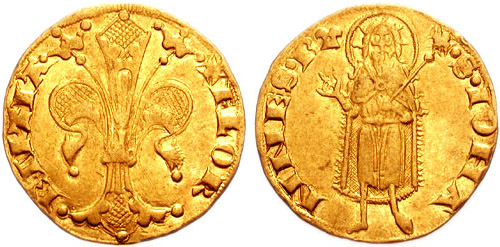
It seems that the younger Hans Schachenmayer had successfully acquired the part of the Hans Rist's mill, because later he managed to own the whole workshop. He also acquired the neighboring paper mill of Elisabetha Staiger, widow of the younger Hans Staiger, another prominent paper-maker of that period. She sold her possession in Kottern for 1,730 fl. This sum was divided into long-term and rising rates. The fact that Hans Schachenmayer dared buying it apparently without capital explained the record of 1615-18 about a small credit he had taken, and about the newly acquired mill which was offered to the creditors as a backup.
The publishing relationship with a Viennese merchant who bereaved the eagle paper (
paper with watermark in the form of the eagle) that Hans Schachenmayer produced had not prevented him from expanding its possession. For instance in 1622, ten years after the purchase of the mill, he acquired for the princely sum of 2,300 fl. from the older Hans Greither (born 1559) a dwelling and farmstead on Oberen Steig ("upper walkway") in the imperial town of Kempten, including a small garden which was adjacent to the city wall.
Of the purchase price he met 1,000 fl. in cash and promised to pay the balance in installments annually up to 150 fl.. Hans Schachenmayer managed probably to possess the largest paper mill in Kempten area. In 1623, he became the spokesman of the Kempten craftsmen paper-makers; he seems to have employed at that time especially many fellow guild members in comparison to his colleagues.
The rise of Schachenmayer within two generations from poor rural backgrounds to the position of saturated master craftsmen is certainly hardly conceivable without luck and proficiency. Technical skills, knowledge in the management and commercial foresight were qualities that had to combine a real paper-maker. Of key importance was also the marriage of the elder Hans Schachenmayer to the granddaughter of the wealthy paper master Moritz Staiger, who procured for him the access to network of monasteries and towns' paper making industry. Such careers were certainly not favored in the 16th and early 17th century under the economic circumstances of trade, relative openness of the craft structures and still permeable boundaries between the religious groups. Only insofar can the family history of the Schachenmayers be considered as exemplary only, as it illustrates basic ways that were, however, much more difficult to realize for less favored paper-makers.
Wolfgang Petz pasted the coat of arms of Hans Schachenmayer from 1622:
It's a double-headed eagle with
K letter for Kempten on the breast-plate. Below it's noticed
1st line:
Hans Schachomair !!!
2nd line
Bürger und Papierer (Citizen and paper-maker)
3rd line:
zu Kempten (in Kempten)
It's more than just similar with Kempten's coat of arms:
What I don't understand is the spelling of family name... Why Schachomair? Mr. Petz didn't explain such a considerable modification... I see only one explanation that it was still the time when the last names had not been fixed for ever and the author is so sure that the Schachenmayers and the Schachomairs represented the same blood line that he even didn't mention it at all.
If you google for the Schachomairs, you'll find the examples of their printed play cards or postal cards from the 16th century:
It was made by Georg (Jörg) Schachomair:
Sheet of playing cards, Georg Schachomair, woodcut, 1575-1600.
Wolfgang Petz also drew a chart of the Staiger's family whereon you may find both of Hans Schachenmayers:
On another website, I stumbled upon a list of paper-making mills' owners and in general points it repeats the story from above, but there are some new details:
in Kempten:
Schachenmeyer, Lucas
Mayr, Martin Bes 1573
Fries, Jerg 1586
Mayr, Abraham Pm 1586
Sommer, Georg 1594
Heusler, Georg 1595
Mayr, Hans 1595
Hurrenbein, Hans 1596
Ebert oder Ebers
Schachenmayr, Johann 1620
Schachenmayr, Hans 1630
Staiger, Michael 1640
Weißner, Essaias Pg 1654
Staiger, Hans 1670
Staiger, Michael 1695
Herz, Domian
Staiger, Moritz 1550 (Gründer)
Schachenmayr, Marx jun. up to 1730
Schachenmayr, Anna Barbara, widow, 1730-1745
Schachenmayr, Johann Lucas from 1745
Schachenmayr, Marx 1816-1853
Forster, Marquard Mit-Bes bis 1848
Schachenmayr, Oskar from 1853
Does it mean that Lukas Schachenmeyer owned a mill before 1573? Mr. Petz didn't mention any Lucas... Johann from 1620 could be the elder Hans, these two forenames were always mixed up, or it's about Jörg? If not, where is a Georg Schachomair? As you can see, the paper industry was under Schachenmayrs until the 19th century.
in Kottern:
Schachenmayr, Hans, guild fellow member, 1584
Schachenmayr, Marx, 1700
Schachenmayr, Jakob, 1700Schachenmayr, Johannes, up to 1834
Behringer, Joh. Georg Bes 1840
Weitenauer, Peter Bes ab 1840
Staiger, Moritz 1528-1547
Mair, Martin 1547
Mair, Abraham 1580
Mair, Matthäus 1593
Reiser, Georg 1593
Staiger, Hans 1601
Baschgott, Bernhard
Walch, Bernhard
Kutter, Georg und Elias (Brüder) Bes 1846
Schachenmayr, Johannes
in Stielings:
Schachenmayr, Johannes, from 1855
in Weidach:
Schachenmayr, Magdalena, widow, 1850
Chronologically it looks like that:
Schachenmeyer, Lucas
Schachenmayr, Hans, guild fellow member, 1584
Schachenmayr, Johann 1620
Schachenmayr, Hans jun. 1630
Schachenmayr, Marx, 1700
Schachenmayr, Jakob, 1700
Schachenmayr, Marx jun. up to 1730
Schachenmayr, Anna Barbara, widow, 1730-1745
Schachenmayr, Johann Lucas from 1745
Schachenmayr, Marx 1816-1853
Schachenmayr, Johannes, up to 1834
Schachenmayr, Magdalena, widow, 1850
Schachenmayr, Oskar from 1853
Schachenmayr, Johannes, from 1855
Well, well, well. If everything from above is true, then you found a clear distinction between the Schachenmayrs and the Schochenmaiers.
1. No carriage industry was mentioned, so it's not the history of the Schochs and Maiers according to Jacob Schochenmaier when two families united their children, business and thus surnames.
2. In its turn, the Schachenmayrs stem from the Schachomairs, which had originated from a place-name in Austria (toponymic origin!).
3. The Schochenmaiers can be traced back from the 1620s, although the Schachenmayers are to be found from the 1450s (
if Michel the Hunter was already dead before 1506)! Now the time gap is pretty big, about 170 years.
4. The Schochenmaiers had started in Alsace-Baden, while the Schachomairs in Austria-Bavaria.
5. The Schachenmayers were pretty rich but the Schochenmeyers were relatively poor and they were clothes-makers.
Now, I am almost sure that the Schochenmeyers and the Schachomairs were not relatives, if only there had been no mistake in the records when the writers messed up A and O in the last names...
